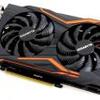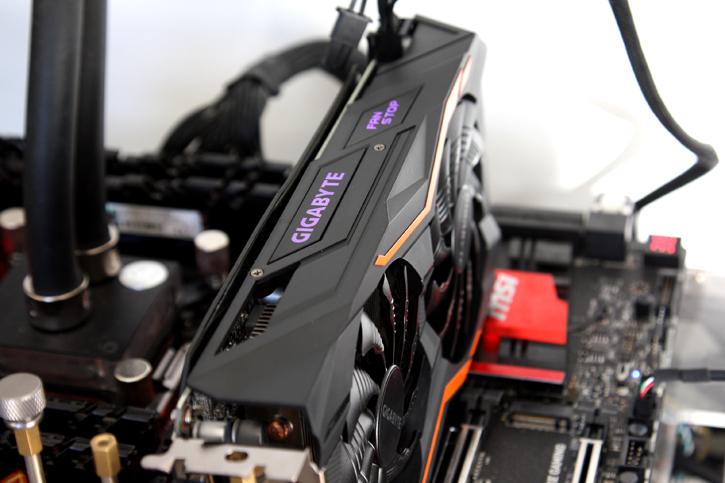Pascal GPU Architecture
GeForce GTX 1050 & 1050 Ti
Alright, we are stepping back to reference material for a second here. The GeForce GTX 1050 / Ti gets a shader processor count of 640 and 768 shader processors. This product can manage clock frequencies that are really high, whilst sticking to a 75 Watt TDP. The Nvidia GeForce GTX 1050 is based on a GP107 GPU which holds over 3 Billion transistors (FinFET). The GeForce GTX 1050 is the card that comes fitted with 7 Gbps GDDR5-memory, and sure, either 2GB or 4GB of it. The reference cards have a base-clock of roughly 1.3 GHz with a boost clock of roughly 1.4 GHz. Board partner products will obviously be clocked a notch faster.
The regular clocked editions of the 1050 and 1050 Ti are capable of achieving say ~2 TFLOP/sec of single precision performance. To compare it a little, a reference design GeForce GTX 980 pushes 4.6 TFLOPS. The change in shader amount is among the biggest differentials together with ROP, TMU count and memory tied to it.
- GeForce GTX 960 has 1,024 shader processors and 2 GB of GDDR5 graphics memory.
- GeForce GTX 970 has 1,664 shader processors and 4 GB of GDDR5 graphics memory.
- GeForce GTX 980 has 2,048 shader processors and 4 GB of GDDR5 graphics memory.
- GeForce GTX Titan X has 3,072 shader processors and 12 GB of GDDR5 graphics memory.
- GeForce GTX 1050 has 640 shader processors and 2 GB of GDDR5 graphics memory.
- GeForce GTX 1050 Ti has 768 shader processors and 4 GB of GDDR5 graphics memory.
- GeForce GTX 1060 3GB has 1,152 shader processors and 3 GB of GDDR5 graphics memory.
- GeForce GTX 1060 6GB has 1,280 shader processors and 6 GB of GDDR5 graphics memory.
- GeForce GTX 1070 has 1,920 shader processors and 8 GB of GDDR5 graphics memory.
- GeForce GTX 1080 has 2,560 shader processors and 8 GB of GDDR5X graphics memory.
The product is obviously PCI-Express 3.0 compatible, it has a max TDP of around 75 Watts with a typical idle power draw of 5 to 10 Watts. That TDP is a maximum overall, and on average your GPU will not consume that amount of power so during gaming that average will be lower. Both cards run cool and silent enough. Pascal GPUs are fabbed at 14 nm FinFET.
Display Connectivity
Nvidia's Pascal generation products will receive a nice upgrade in terms of monitor connectivity. First off, the cards will support three DisplayPort connectors, one HDMI connector and a DVI connector. The days of Ultra High resolution displays are here, Nvidia is adapting to it. The HDMI connector is HDMI 2.0 revision b which enables:
- Transmission of High Dynamic Range (HDR) video
- Bandwidth up to 18 Gbps
- 4K@50/60 (2160p), which is 4 times the clarity of 1080p/60 video resolution
- Up to 32 audio channels for a multi-dimensional immersive audio experience
DisplayPort wise compatibility has shifted upwards to DP 1.4 which provides 8.1 Gbps of bandwidth per lane and offers better color support using Display Stream Compression (DSC), a "visually lossless" form of compression that VESA says "enables up to 3:1 compression ratio." DisplayPort 1.4 can drive 60 Hz 8K displays and 120 Hz 4K displays with HDR "deep color." DP 1.4 also supports:
- Forward Error Correction: FEC, which overlays the DSC 1.2 transport, addresses the transport error resiliency needed for compressed video transport to external displays.
- HDR meta transport: HDR meta transport uses the “secondary data packet” transport inherent in the DisplayPort standard to provide support for the current CTA 861.3 standard, which is useful for DP to HDMI 2.0a protocol conversion, among other examples. It also offers a flexible metadata packet transport to support future dynamic HDR standards.
- Expanded audio transport: This spec extension covers capabilities such as 32 audio channels, 1536kHz sample rate, and inclusion of all known audio formats.
High Dynamic Range (HDR) Display Compatibility
Nvidia obviously can now fully support HDR and deep color all the way. HDR is becoming a big thing, especially for the movie aficionados. Think better pixels, a wider color space, more contrast and more interesting content on that screen of yours. We've seen some demos on HDR screens, and it is pretty darn impressive to be honest. By this year you will see the first HDR compatible Ultra HD TVs, and then next year likely monitors and games supporting it properly. HDR is the buzz-word for 2016. With Ultra HD Blu-ray just being released in Q1 2016 there will be a much welcomed feature, HDR. HDR will increase the strength of light in terms of brightness. High-dynamic-range rendering (HDRR or HDR rendering), also known as high-dynamic-range lighting, is the rendering of computer graphics scenes by using lighting calculations done in a larger dynamic range. This allows preservation of details that may be lost due to limiting contrast ratios. Video games and computer-generated movies and special effects benefit from this as it creates more realistic scenes than with the more simplistic lighting models used. With HDR you should remember three things: bright things can be really bright, dark things can be really dark, and details can be seen in both. High-dynamic-range will reproduce a greater dynamic range of luminosity than is possible with digital imaging. We measure this in Nits, and the number of Nits for UHD screens and monitors is going up. What's a nit? Candle brightness measured over one meter is 1 nits, the sun is 16,000,000,000 nits, typical objects have 1~250 nits, current PC displays have 1 to 250 nits, and excellent HDTVs have 350 to 400 nits. An HDR OLED screen is capable of 500 nits and here it’ll get more important, new screens in 2016 will go to 1,000 nits. HDR offers high nits values to be used. We think HDR will be implemented in 2016 for PC gaming, Hollywood has already got end-to-end access content ready of course. As consumers start to demand higher-quality monitors, HDR technology is emerging to set an excitingly high bar for overall display quality. HDR panels are characterized by: Brightness between 600-1200 cd/m2 of luminance, with an industry goal to reach 2,000 contrast ratios that closely mirror human visual sensitivity to contrast (SMPTE 2084) And the Rec.2020 color gamut that can produce over 1 billion colors at 10 bits per color HDR can represent a greater range of luminance levels than can be achieved using more "traditional" methods, such as many real-world scenes containing very bright, direct sunlight to extreme shade, or very faint nebulae. HDR displays can be designed with the deep black depth of OLED (black is zero, the pixel is disabled), or the vivid brightness of local dimming LCD. Now meanwhile, if you cannot wait to play games in HDR and did purchase a HDR HDTV this year, you could stream it. An HDR game rendered on your PC with a Pascal GPU can be streamed towards your Nvidia Shield Android TV and then over HDMI connect to that HDR telly as Pascal has support for 10 bit HEVC HDR encoding and the Shield Android TV can decode it. Hey, just sayin'. A selection of Ultra HDTVs are already available, and consumer monitors are expected to reach the market late 2016 and 2017. Such displays will offer unrivaled color accuracy, saturation, brightness, and black depth - in short, they will come very close to simulating the real world.


